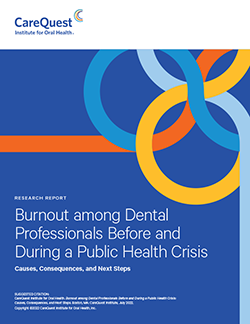Nearly three-quarters (71%) of oral health providers said their feelings of burnout had increased since the start of the COVID-19 pandemic, according to a visual report from CareQuest Institute.
To learn more about the effect of the pandemic on burnout, CareQuest Institute conducted a survey of 377 dental providers in March 2021. In general, oral health providers reported increases in burnout during the beginning of the pandemic. However, this sense of increased burnout did not impact all dental providers equally, with differences by gender, age, race, and ethnicity emerging. Key findings include:
- Frequent feelings of burnout were reported most by the youngest group of providers (71% for providers aged 18–34 compared to 46% for providers aged 55 and over).
- Two-thirds (66%) of female providers reported frequent feelings of burnout compared with half (50%) of male providers.
- Oral health providers identifying as Hispanic were more likely (73%) to report burnout symptoms due to work compared with individuals identifying as white (63%), Asian/American Indian/Native Hawaiian/Pacific Islander (55%), or Black (35%).
- Oral health providers in rural areas experienced frequent burnout at higher rates (72%) than providers in suburban/urban areas (56%).
Professional burnout can lead to physical and psychological distress and is associated with higher rates of suicide among health care workers. The visual report also includes resources to help dental professionals overcome burnout.
You may also be interested in:
- Speaking Softly and Still Being Heard, a blog post from the perspective of a dental hygienist who shares advice about how to advocate for yourself in a professional setting.
- Dental Safety Net Providers’ Experiences with COVID-19 Should Inform Dental Pandemic Preparedness, an article in the Journal of the American Dental Association that describes providers’ experiences delivering care in the early stages of the pandemic.
- Dentist Perceptions about the Value of Teledentistry, a journal article showing that most dentists expect teledentistry to change how they practice with benefits including improved access to care and reduced chair time, allowing them to see more patients.
